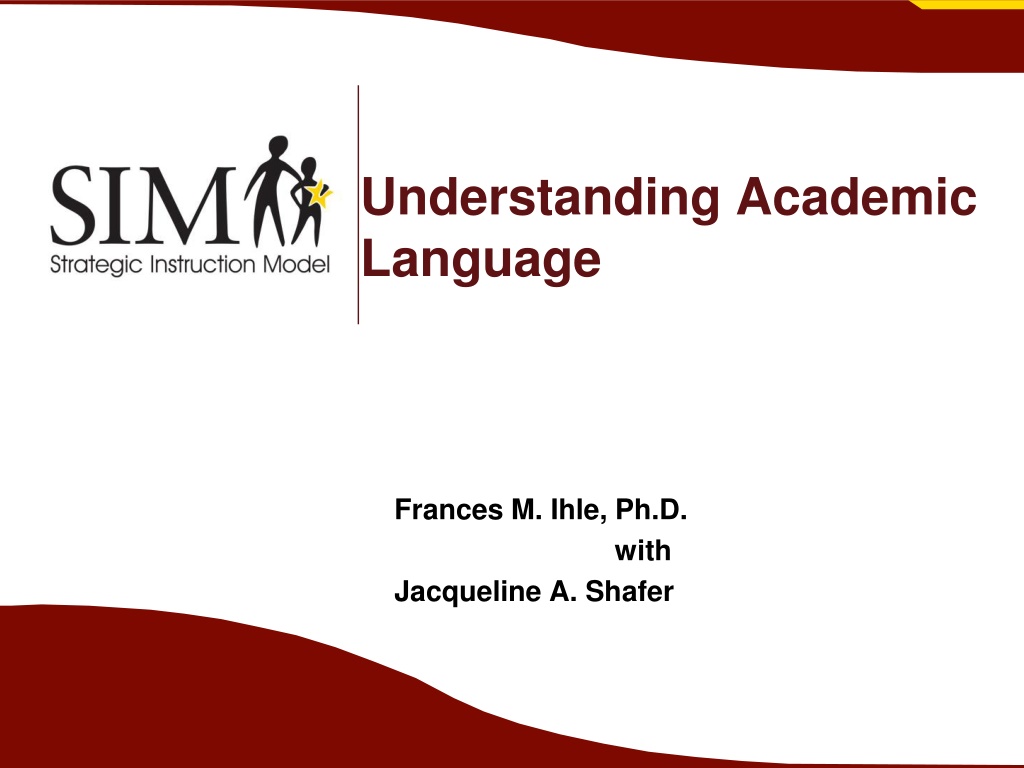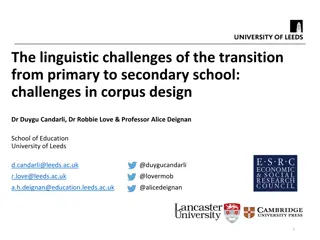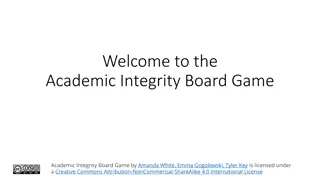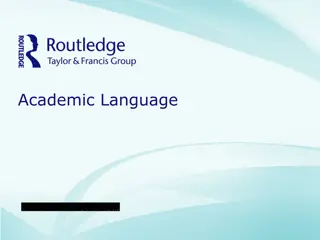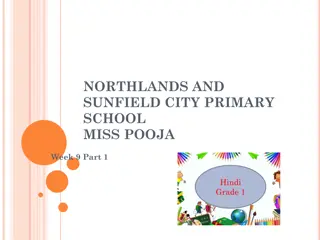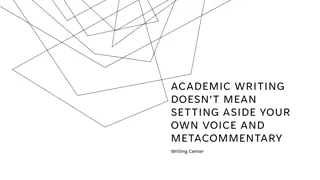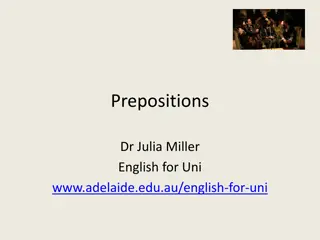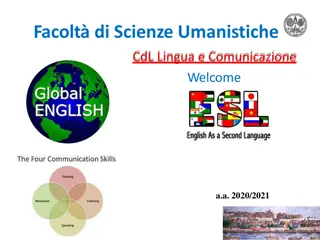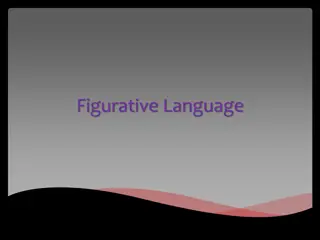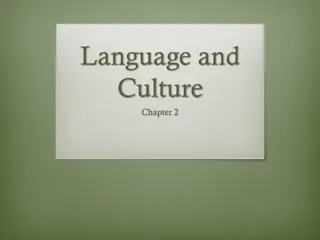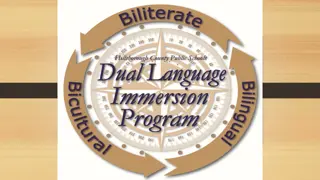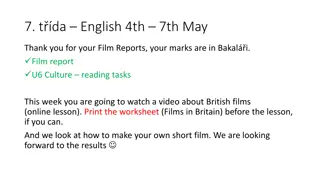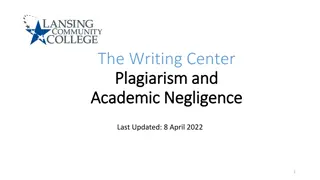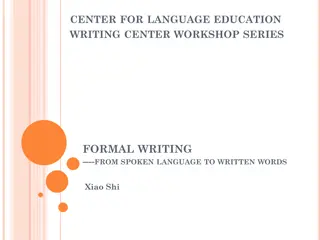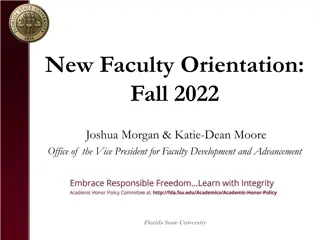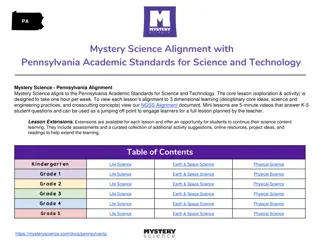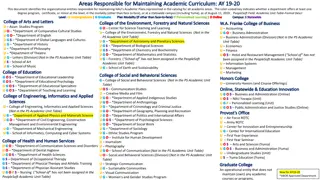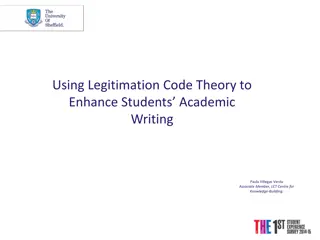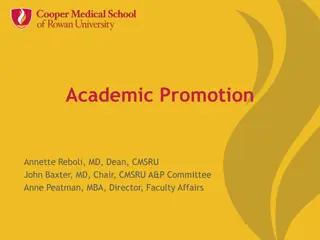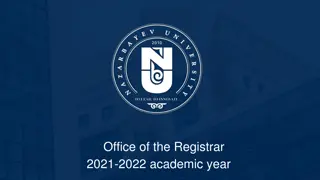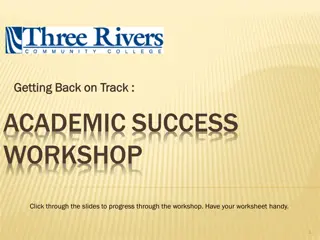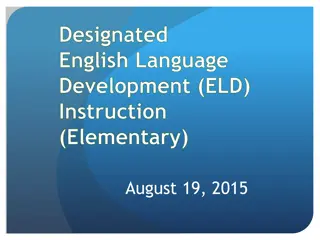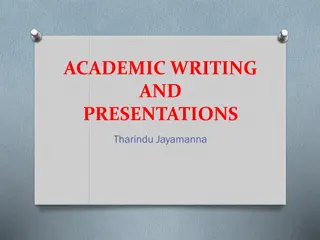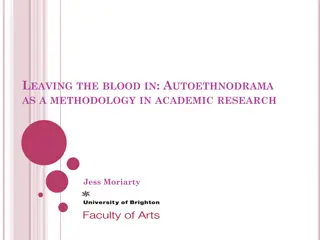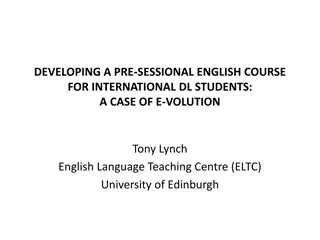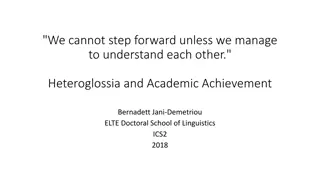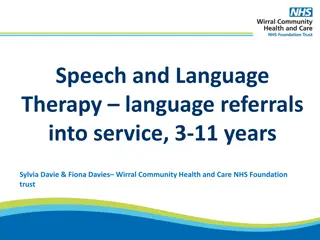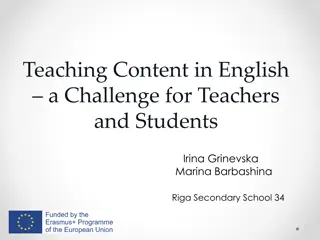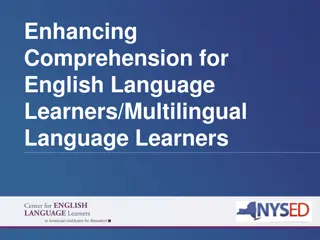Understanding Academic Language Lessons and Examples
Explore the fundamentals of academic language through various lessons including noun phrases, active vs. passive voice, connectives, and pronouns. Understand how to structure sentences and convey ideas effectively in academic writing.
Download Presentation

Please find below an Image/Link to download the presentation.
The content on the website is provided AS IS for your information and personal use only. It may not be sold, licensed, or shared on other websites without obtaining consent from the author. Download presentation by click this link. If you encounter any issues during the download, it is possible that the publisher has removed the file from their server.
E N D
Presentation Transcript
Understanding Academic Language Frances M. Ihle, Ph.D. with Jacqueline A. Shafer
What is academic language? Examples (indicated by red underlined text) Lesson 2: Noun phrases A group of related words that play the role of a noun. May include articles (the, a, this), adjectives (happy, fast, shy), nouns (boy, cat, ship) prepositional phrases (on the ground, after the party, over the moon). The sleepy old dog on the chair snored loudly. A speedy runner in the race finished in first place.
What is academic language? Lesson 3: Active vs. Passive Voice Voice is the form of a verb that shows whether the subject of a sentence does the action (active voice) is affected by the action (passive voice) Authors use passive voice to distance themselves from the message Examples (indicated by blue italicized text) Active voice The dog bit my brother. The student took the test. Passive voice My brother was bitten by the dog. The test was taken by the student.
What is academic language? Examples (indicated by grey bold text) Lesson 4: Connectives Words that link or connect ideas within a written passage. They can be used within a sentence to link two or more ideas together to link together ideas in separate sentences or paragraphs Milo ran into the kitchen because he wanted to eat dinner. My sister was pulled over for speeding. Therefore, she was given a ticket.
What is academic language? Examples (indicated by green text) Lesson 5: Pronouns Word used to replace or refer to one or more nouns Pronouns make writing more interesting and less repetitive passages more complex because readers must identify the words to which they refer He and I went to the store. The little girl was riding her bike. A scary house sat on their block.
Some examples Noun Phrases The farmer planted a tree. The large tree was planted by the farmer. + Passive Voice The large green plantation in the tropical rainforest was cared for by the farmer. + Therefore, the large green plantation in the tropical rainforest was cared for by the farmer before it was destroyed. Connectives + Pronouns
ELA CCSSLanguage standards (6-12) 1. Conventions of standard English: Grade 6 Recognize and correct (c) inappropriate shifts in pronoun number and person.* (d) vague pronouns (i.e., ones with unclear or ambiguous antecedents).* (e) variations from standard English in their own and others writing and speaking* Grade 7 (c) Place phrases and clauses within a sentence, including misplaced and dangling modifiers.* Grade 9-10 (b) Use various types of phrases (noun, verb, adjectival, adverbial, participial, prepositional, absolute) and clauses (independent, dependent; noun, relative, adverbial) to convey specific meanings. Lesson #: 5 2, 3, 4, 5 2, 4 2. Knowledge of language Grade 8 (a) Use verbs in the active and passive voice and in the conditional and subjunctive mood to achieve particular effects Grade 11-12 (a) Vary syntax for effect; apply an understanding of syntax to the study of complex texts when reading. 3 2, 3, 4, 5
Building Blocks for Content Literacy HIGHER ORDER THINKING Content enhancement SUBJECT MATTER ADVANCED AUTOMATIC SKILLS Learning strategies COGNITIVE STRATEGIES BASIC or STUDY SKILLS LANGUAGE
Content-specific strategies (Christie, 2002; Shanahan & Shanahan, 2008; Shanahan, Shanahan, & Misischia, 2011) History Science Math E/LA sourcing, corroborating, and contextualizing self-questioning to clarify mental processes developing familiarity with literary techniques close reading and re-reading STRATEGIES analyzing, interpreting, and critiquing events understanding problems and solutions developing abstract reasoning skills transforming information PURPOSE FOR READING
Language patterns across texts... History (Coffin, 2004; 2006; Martin, 2002; Schleppegrell, Achugar, & Oteiza, 2004; Shanahan & Shanahan, 2008; Shanahan, Shanahan, & Misischia, 2011; Wolfe & Goldman, 2005) Science (Esquinca, 2007; Fang, 2005; Shanahan & Shanahan, 2008; Shanahan, Shanahan, & Misischia, 2011; Young & Nguyen, 2002) Math ELA (Shanahan & Shanahan, 2008; Shanahan, Shanahan, & Misischia, 2011) (Christie, 2002; Swiderski, 2007) Expository procedures and reports Narrative and expository Narrative and expository Expository and argumentation Discourse Causal and temporal relations, passive voice, and noun phrases Causal and temporal relations, passive voice, and noun phrases Causal and temporal relations and noun phrases Logical relations and formulas Text Structure
Research Results Original (2011) study Content area passage and questions Comparison (n = 25) Change from pretest to posttest 0.971 Effect Size 1.960 Experimental (n = 24) 28.654 Confirmation (2013) study Content area passage and questions Comparison (n = 8) Change from pretest to posttest 1.429 Experimental (n = 12) 18.330
Introduction Learning Strategies In almost every educational setting there are some students who are low achievers. The causes of low achievement are varied, but in many instances, students perform poorly because they have not learned how to learn. Research over the past three decades has shown that students can be taught how to learn by teaching them learning strategies. A learning strategy is an individual s approach to learning a task. It includes how an individual thinks and acts when planning, executing, and evaluating performance on a task and its outcomes. Learning strategy instruction focuses on both how to learn and how to effectively use what has been learned. Understanding Academic Language Understanding Academic Language is a learning strategy that can help students better comprehend the content of their language arts, science, social studies, and math textbooks. The strategy is an integral part of the Learning Strategies Curriculum, a research-based series of instructional programs designed to help students meet the rigorous demands of educational settings. (For an overview of the Learning Strategies Curriculum, see Figure 1.) The Learning Strategies Curriculum Figure 1. The Learning Strategies Curriculum Expression & Demonstration of Competence Strategies Fundamentals of Sentence Writing Proficiency in Sentence Writing Acquisition Strategies Storage Strategies Word Identification FIRST-Letter Mnemonic Visual Imagery Paired Associates Self-Questioning LINCS Vocabulary EDIT Fundamentals of Paraphrasing & Summarizing Listening and Note-taking Paragraph Writing Paraphrasing Theme Writing Word Mapping Assignment Completion Inference Test-Taking Understanding Academic Language Essay Test-Taking 1
The Interactive Manual Table of Contents Introduction ................................ ................................ ................................ ........... 1 Lesson 1: Pretest ................................ ................................ ................................ .... 3 Lesson 2: Tune into the Noun Phrases ................................ ................................ ...... 5 Lesson 3: Evaluate Active/Passive Voice ................................ ................................ . 10 Lesson 4: eXamine the Relationships ................................ ................................ ...... 14 Lesson 5: Track the Pronouns ................................ ................................ ................ 18 Lesson 6: Posttest ................................ ................................ ................................ . 22 Appendix A | Scoring and Evaluation Guidelines ................................ ...................... 23 Appendix B | Instructional Materials ................................ ................................ ...... 24 Appendix C | Learning Sheets ................................ ................................ ................ 42 Appendix D | Answer Key ................................ ................................ ...................... 75
Lesson 1 and 6: Pretest and Posttest Name ______________________________________________ Date_____________________ Name ______________________________________ Date_____________________ Posttest #1 Pretest #1 Directions: Read the passage until you come to three bold words in parentheses. Decide which Directions: Read the passage until you come to three bold words in parentheses. Decide which one of these words best fits into the sentence and circle it. Be sure to read the whole one of these words best fits into the sentence and circle it. Be sure to read the whole sentence before choosing your answer. sentence before choosing your answer. A cell is the smallest unit of an organism that (is, are, be) still considered living. Cells are the basic (organism, beam, units) that make up every type of organism. (An, All, Some) The First World War (was, been, were) a tragedy that left over twenty million dead. organisms, like bacteria, consist of only one cell. Other (organisms, beams, units), like (This, Those, A) war also planted the seeds for the Second World (Age, Alliance, War) that humans, consist (of, for, on) trillions of specialized cells working together. (Until, In order happened two decades later. It marked the end of the gilded industrial (factor, seed, age) of to, Even if) organisms look very different (for, from, of) each other, if you look close enough the European empires. This era (is, was, were) replaced with a new time of struggling you ll (see, look, seen) that their cells have much (in, over, on) common. republics and (decades, ages, governments) in Eastern Europe. (Once, First, Eventually), Most cells are so tiny that you can t see them without (a, this, the) help of a the Soviet Union was created. microscope. The microscopes that students typically use at school (is, are, were) light It is obvious that (a, those, the) world was changed dramatically by the war. microscopes. Robert Hooke created (a, this, they) primitive light microscope in 1665 (and, (However, At once, Although), the causes of the conflict are confusing. They form a (line, but, so) observed cells for the very first time. (Unless, Although, Once) the light microscope navy, government) of deadly dominoes that only became apparent (while, now that, after) opened our eyes (to, for, at) the existence of cells, (this, they, the) are not useful for the assassination of Austria-Hungarian Archduke Franz Ferdinand (in, around, on) Bosnia on looking at the tiniest components (of, over, for) cells. Many structures in the cell (is, were, June 28, 1914. are) too small to see with a light microscope. The main factor (from, behind, on) the evolution of events that led to World War I (When, Before, Until) scientists developed more powerful microscopes in the 1950s, (been, was, seem) the system of European alliances. (These, An, This) agreements the (microscope, field, unit) of cell biology grew rapidly. (A, This, They) light microscope developed in the decades before the (age, time, conflict). Following the Franco-Prussian passes a light (cell, beam, school) through a specimen, (but, by, until) the more powerful War, German (Russian, Chancellor, Factor) Otto Von Bismarck sought (these, them, an) electron microscope (looks, has, passes) a beam of electrons (over, through, by) the alliance with Russia. He wanted to deter a French (attempt, occurrence, age) to regain the specimen, allowing a much closer lookat the cell. lost territory of Alsace-Lorraine. (While, Until, After) Bismarck resigned in 1890, German Emperor Wilhelm II ended the Russian (alliance, event, age). He then focused on building stronger (relations, conflicts, governments) with Austria-Hungary. This occurrence only worsened relations (with, from, to) Russia. Austria-Hungary most likely mobilizedagainst Russia following the formation of (these, this, those) alliance. 28 25
The strategy steps... Tune into the noun phrases Evaluate active/passive voice eXamine the connectives Track the pronouns
The strategy steps... Tune into the noun phrases
Parts of noun phrases Cue Card #5 Elements of Noun Phrases pack refuse avoid occupy inhabit employ work paint move operate -age -al -ance -ancy -ant -ee -er -ing -ment -tion Main subjects Ordering words Describing words Prepositional phrases Articles the third big relationship in his life the only tired runner in the race the two long applications for a job a lone angry fighter on our side from the court a single harsh punishment 35
Cue Card #3 Changing Verbs into Nouns Used in a sentence as a VERB He packed the books into a box. Used in a sentence as a NOUN VERB 1. Pack SUFFIX -age 2. Refuse He refused to smoke the cigarette. -al 3. Inherit They inherited the gift from her grandfather. The students occupied the classroom. -ance 4. Occupy -ancy 5. Inhabit -ant 6. Employ -ee 7. Work -er 8. Paint -ing 9. Argue -ment 10. Operate -tion
Cue Card #4 Transformers Transformers Certain suffixes can be used to change verbs into nouns. Examples -age -al -ance -ancy -ant -ee -er -ing -ment -tion package refusal inheritance occupancy inhabitant employee worker painting argument operation 34
Cue Card #3 Changing Verbs into Nouns Used in a sentence as a VERB He packed the books into a box. Used in a sentence as a NOUN The package was sent in the mail. VERB 1. Pack SUFFIX -age 2. Refuse He refused to smoke the cigarette. -al His refusal to smoke was a smart choice. 3. Inherit They inherited the gift from her grandfather. The students occupied the classroom. The bears inhabit the cave. -ance 4. Occupy -ancy 5. Inhabit -ant 6. Employ After the interview, they can employ her. The people work on their cardio. The elephant paints a picture. -ee 7. Work -er 8. Paint -ing 9. Argue The couple argued over something. The doctor operated on the knee. -ment 10. Operate -tion
Verbs VS. Noun Phrases marry an extremely short marriage apply the important application hear a public hearing violate a gross violation punish the harsh punishment feel the sinking feeling
Cue Card #5 Elements of Noun Phrases Main subjects Ordering words Describing words Prepositional phrases Articles the third big relationship in his life the only tired runner in the race the two long applications for a job a lone angry fighter on our side from the court a single harsh punishment 35
Ordering words Cue Card #5 Elements of Noun Phrases Cue Card #6 Main subjects Ordering words Describing words Prepositional phrases Articles Ordering Words the third big relationship in his life double first best one next triple second higher three last the only tired runner in the race quadruple fourth lower four sole multiple fifth better many few the two long applications for a job a lone angry fighter on our side from the court a single harsh punishment 36 35
Model and Controlled Practice 1. The ________________book is my favorite. 2. The ______________ package was filled to the top. 3. The _________________ racer flashed across the finish line. 4. The _________________ argument pierced our ears. 5. The _________________ girl wore a blue sweater.
Describing words Cue Card #5 Elements of Noun Phrases Cue Card #7 Describing Words Main subjects Ordering words Describing words Prepositional phrases Articles cute artistic small educated the third big relationship in his life spicy fancy beastly fantastic crazy ugly amazing sad the only tired runner in the race incredible mad funny confused the two long applications for a job awesome enormous cool old normal painful weird annoying a lone angry fighter on our side happy scary large strange from the court a single harsh punishment 37 35
Model and Controlled Practice 1. The ________________book is my favorite. 2. The ______________ package was filled to the top. 3. The _________________ racer flashed across the finish line. 4. The _________________ argument pierced our ears. 5. The _________________ girl wore a blue sweater.
Prepositional phrases Cue Card #5 Elements of Noun Phrases Cue Card #8 Main subjects Common Prepositions & Example Prepositional Phrases Ordering words Describing words Prepositional phrases Articles about after against about your question after the test against the wall the third big relationship in his life around at before around the clock at my door before the party below between by below the shelf between the houses by the crooked stream the only tired runner in the race during for from during the thunderstorm for an hour or two from the airport in into of in a perfect world into the darkness of all the choices the two long applications for a job on out over on target out the window over the top through to under through thick or thin to the store under the roof upon with without a lone angry fighter on our side upon my honor with great distinction without a worry from the court a single harsh punishment 38 35
Model and Controlled Practice Learning Sheet 2C Learning Sheet 2D Structuring Noun Phrases with Prepositional Phrases Structuring Noun Phrases with Ordering Words, Describing Words, and Prepositional Phrases Directions: Fill in a prepositional phrase to the right of the main subject to form a Directions: Fill in the blanks for each sentence using the ordering words, describing grammatically correct noun phrase. words, and prepositional phrases created in Learning Sheets #2A-2C. Place the ordering words and describing words in the correct sequence before the main subject and the prepositional phrase after the main subject. 1.The book _________________________________ is my favorite. 2.The package _________________________________ was filled to the top. 1.The ________________ ________________ book ________________________ is my favorite. 3.The racer _________________________________ flashed across the finish line. 2.The ______________ ________________ package _______________________ 4.The argument _________________________________ pierced our ears. was filled to the top. 5.The girl _________________________________ wore a blue sweater. 3.The ________________ ________________ racer ________________________ flashed across the finish line. 4.The ________________ ________________ argument _____________________ pierced our ears. 5.The ________________ ________________ girl _________________________ wore a blue sweater. 45 46
The strategy steps... Tune into the noun phrases Evaluate active/passive voice
Parts of a sentence The subject is the noun that the sentence is about. The verb shows the action or state of being of the subject.
Look at the SUBJECT of the sentences Jonah picked up the baby. The baby was picked up by Jonah. The water leak destroyed the computer. The computer was destroyed by the water leak.
Describe Active Voice The subject of the sentence DOES the action Passive Voice The subject of the sentence IS AFFECTED BY the action Examples: The computer was destroyed by the flood. The book was placed on the table by Jonah. The ball was thrown by the catcher. The belly of the cat was scratched by Toby. Examples: The flood destroyed the computer. Jonah placed the book on the table. The catcher threw the ball. Toby scratched the cat s belly.
Model and Controlled Practice 1. The student read the book. 2. The book was read by the student. 3. Bill invited Emily to the dance. 4. Emily was invited to the dance by Bill. 5. Peter swept up the pieces of broken glass. 6. The pieces of broken glass were swept up by Peter.
Advanced Practice 1. All graduates were honored at the reception. 2. Jan speaks fluent Italian. 3. The car was loaned to me. 4. Yogurt and berries were quickly consumed by the hungry child. 5. John listened politely to Martha s presentation. 6. The group of friends meets every Tuesday to knit.
The strategy steps... Tune into the noun phrases Evaluate active/passive voice eXamine the connectives
Connectives Connectives are words that link two or more ideas WITHIN a sentence or BETWEEN sentences There are 4 types of connectives
Cue Card #10 Connectives Connectives are words that link two or more ideas WITHIN a sentence or BETWEEN sentences. 1.Temporal Connectives are used to indicate order, sequence, or importance. Example: John left the house as soon as Paulette called. after before already finally as soon as first at last meanwhile at once next at the same time now 2.Causal Connectives are used to show cause and effect. Example: As a result of the bad economy, several people lost their jobs. admittedly because although but as by as a result consequently as long as even though 3.Additive Connectives are used to add further information. Example:In addition to Disneyland, the couple spent a day at the beach. also but and furthermore another however as well as in addition besides in fact 4.Comparative Connectives are used to show how ideas are alike or different. Example: Sam enjoys hockey, whereas Ben prefers baseball. actually either-or again even if although except alternatively for example as if if conversely if not-then Temporal Connectives now that once previously recently since still subsequently until then when while however in conclusion in order to nevertheless nonetheless since so so that therefore thus until in summary indeed just as moreover nevertheless nonetheless nor provided that too in contrast in fact instead like neither-nor on the one hand on the other hand rather than similarly that is unless whereas 40
Cue Card #10 Connectives Connectives are words that link two or more ideas WITHIN a sentence or BETWEEN sentences. 1.Temporal Connectives are used to indicate order, sequence, or importance. Example: John left the house as soon as Paulette called. after before already finally as soon as first at last meanwhile at once now that once previously recently since still subsequently until then when while Causal Connectives next at the same time now 2.Causal Connectives are used to show cause and effect. Example: As a result of the bad economy, several people lost their jobs. admittedly because although but as by as a result consequently as long as even though 3.Additive Connectives are used to add further information. Example:In addition to Disneyland, the couple spent a day at the beach. also but and furthermore another however as well as in addition besides in fact 4.Comparative Connectives are used to show how ideas are alike or different. Example: Sam enjoys hockey, whereas Ben prefers baseball. actually either-or again even if although except alternatively for example as if if conversely if not-then however in conclusion in order to nevertheless nonetheless since so so that therefore thus until in summary indeed just as moreover nevertheless nonetheless nor provided that too in contrast in fact instead like neither-nor on the one hand on the other hand rather than similarly that is unless whereas 40
Cue Card #10 Connectives Connectives are words that link two or more ideas WITHIN a sentence or BETWEEN sentences. 1.Temporal Connectives are used to indicate order, sequence, or importance. Example: John left the house as soon as Paulette called. after before already finally as soon as first at last meanwhile at once next at the same time now 2.Causal Connectives are used to show cause and effect. Example: As a result of the bad economy, several people lost their jobs. admittedly because although but as by as a result consequently as long as now that once previously recently since still subsequently until then when while however in conclusion in order to nevertheless nonetheless since so so that therefore thus until Additive Connectives even though 3.Additive Connectives are used to add further information. Example:In addition to Disneyland, the couple spent a day at the beach. also but and furthermore another however as well as in addition besides in fact 4.Comparative Connectives are used to show how ideas are alike or different. Example: Sam enjoys hockey, whereas Ben prefers baseball. actually either-or again even if although except alternatively for example as if if conversely if not-then in summary indeed just as moreover nevertheless nonetheless nor provided that too in contrast in fact instead like neither-nor on the one hand on the other hand rather than similarly that is unless whereas 40
Cue Card #10 Connectives Connectives are words that link two or more ideas WITHIN a sentence or BETWEEN sentences. 1.Temporal Connectives are used to indicate order, sequence, or importance. Example: John left the house as soon as Paulette called. after before already finally as soon as first at last meanwhile at once next at the same time now 2.Causal Connectives are used to show cause and effect. Example: As a result of the bad economy, several people lost their jobs. admittedly because although but as by as a result consequently as long as even though 3.Additive Connectives are used to add further information. Example:In addition to Disneyland, the couple spent a day at the beach. also but and furthermore another however as well as besides 4.Comparative Connectives are used to show how ideas are alike or different. Example: Sam enjoys hockey, whereas Ben prefers baseball. actually either-or again even if although except alternatively for example as if if conversely if not-then now that once previously recently since still subsequently until then when while however in conclusion in order to nevertheless nonetheless since so so that therefore thus until in summary indeed just as moreover nevertheless nonetheless nor provided that too Comparative Connectives in addition in fact in contrast in fact instead like neither-nor on the one hand on the other hand rather than similarly that is unless whereas 40
Model and Controlled Practice 1. Ryan went to the store because he was out of cereal. 2. At our school, Mrs. Henderson teaches math, and Mr. Martinez teaches science. 3. Amber ran to third base while the outfielder quickly scooped up the ball.
Learning Sheet 4E Choose the Correct Connective (Advanced Practice, Part 1) Directions: Read the selection below and identify the correct connective from the Advanced Practice (part 1) choices provided. I missed him every single day (but, after, then) the horrible event took place. I tried to tolerate Miss Watson s worried words, (after, because, but) it soon got tiresome. To avoid her pecking, I went up to my room with a piece of candle, put it on the table, and sat down in a chair. I felt lonesome and almost wished I was dead. The stars were shining and the leaves rustled in the woods mournfully. (Next, At last, However), I heard an owl who-whooing about somebody that was dead, and a whippoorwill and a dog crying about somebody that was going to die. The wind tried to whisper something to me. (Previously, First, Nevertheless), I couldn t make out what it was, (by, so, until) it made the cold shivers run over me. 58
Learning Sheet 4I Identify the Unmarked Connective (Advanced Practice, Part 2) Advanced Practice (part 2) Directions: Read the selection and circle five unmarked connectives. Chen Ma s son lived with his elderly mother inside a forest. He followed the profession of his father and grandfather, as he was a licensed tiger hunter. His share of the profits from the sale of tiger skins, meat and bones was sufficient to keep the small mud hut well provisioned for himself and his old mother. All was well until a particularly bitter winter came about. During a snowstorm, Chen Ma s son was separated from his fellow hunters. Consequently, he became food for a hungry tigress. Chen Ma took stock of her own utterly desperate situation after her initial shock and grief had subsided. She went and asked the magistrate to provide her with money since she had lost her son who was her only source of support. 62
The strategy steps... Tune into the noun phrases Evaluate active/passive voice eXamine the connectives Track the pronouns
Pronouns A word that takes the place of a noun or refers to a noun Examples I, me he, him you she, her it we, us they, them my, mine your, yours his her, hers its our, ours their, theirs myself themselves himself yourself herself yourselves ourselves itself this these that those
Model and Controlled Practice 1. Marjorie is a good swimmer; she has won many competitions. 2. Mike put the dirty jeans in the washing machine. Thirty minutes later, he transferred them to the dryer. 3. The books were on the floor. Flora put them back on the shelf. 4. Ty is very selfish; he needs to think about people other than himself.
Learning Sheet 5F Tracking Pronouns in NARRATIVE PASSAGES (Advanced Practice) Directions: Using the Pronouns Chart, find and circle all pronouns in the following Advanced Practice (Narrative) passage. Then draw an arrow between the pronoun and the noun it is referring to. Chen Ma s son lived with his elderly mother inside a forest. He followed the family profession and was a licensed tiger hunter. His share of the profits from the sale of tiger skins, meat, and bones was sufficient to keep the small mud hut well provisioned for himself and Chen Ma. All was well until a particularly bitter winter came about. During a snowstorm, Chen Ma s son was separated from the other hunters and became food for a hungry tigress. Chen Ma took stock of her own utterly desperate situation after the initial shock and grief had subsided. 69
Learning Sheet 5H Tracking Pronouns in an EXPOSITORY SCIENCE PASSAGE (Advanced Practice) Directions: Using the Pronouns Chart, find and circle all pronouns in the following Advanced Practice (Expository) passage. Then draw an arrow between the pronoun and the noun it is referring to. An ecosystem is defined as a place. It also includes all living things and all of their connections. Plants help animals by providing them with food. Animals then help plants as they carry seeds to different locations and leave droppings. Thus, the living things in one place interact. They fit together like the pieces of a puzzle. Scientists call the puzzle an ecosystem. 71
Generalization Embed activities throughout instruction Suggestions: Locate academic language in content area textbooks Translate everyday words into academic language Draw pictures or use games to scaffold abstract language
